General
The Fantasound Follies continue
In a special Thursday edition of his column, Wade Sampson expands on his earlier stories about Walt Disney Productions’ early experiments with stereophonic sound.

Given that there was so much JHM reader interest in my earlier story about Fantasound, I thought that I might continue the tale. This time by reprinting a July 1942 magazine article written by Edward H. Plumb, who worked in the music department of Walt Disney Studios at the time. This story examines “Fantasound” from the musician’s point of view.
“The Future of Fantasound”
Fantasound has been demonstrated to the public only in Walt Disney’s “Fantasia.” But to accept or reject Fantasound on the basis of its use in that picture would be unjust. “Fantasia” is a remarkable showcase for an experiment in sound engineering because it uses music as a vital function of the picture.
However, the dramatic effectiveness of Fantasound was limited by three conditions peculiar to this production.
(1) During its actual picture footage, “Fantasia” uses only music on the sound-track. This eliminates the possibility of placing and moving dialog or sound-effects in the multiple speaker system that Fantasound includes. Dialog and sound-effects are the “real” sounds of the movies with which the audience is thoroughly familiar. Because of this familiarity it is quite possible that the location of these sounds in the theater could be more easily registered than the placement of musical sounds.
(2) The music that “Fantasia” interprets was conceived long before sound-film was available for use. The compositions were designed for concert performance and were so well designed for that medium that any orchestral changes made to improve reproduction greatly affected their basic character:
(3) The original recording of the entire orchestral performance of “Fantasia” had been completed before it was known what dimensional effects would be available in the theater. It was thus impossible to guess what method of recording would be most efficient for reproduction in Fantasound.
This is in no sense to be interpreted as an apology for “Fantasia” or the methods used in it. It is merely a description of certain obstacles that would not be confronted in the usual feature.
The future of Fantasound depends upon the efficiency with which the original sound material can be transferred to film and upon the dramatic effectiveness of the total result. These related factors dictate the future of Fantasound because they represent, respectively, the expenditure necessary and the expenditure warranted by box office returns.
Before suggesting a method of recording an orchestra that might be practicable for future productions in Fantasound it seems advisable to describe briefly the method employed in Fantasia. During the original performance, each of six sound cameras recorded the close pick-up of a particular section of the orchestra. A seventh camera recorded a blend of these six close pick-ups, and an eighth recorded a distant pick-up of the entire orchestra.
In preparing the final re-recorded track from this original material several weaknesses became apparent. Because of acoustical pick-up the separation between the six sections of the orchestra was merely relative. In the material on the woodwind channel, for instance, the woodwinds usually predominated, but material from other sections of the orchestra was definitely present. Many times, because of differences in performance level, the material from adjacent sections would be as loud as, or louder than, the woodwinds directly picked up.
This lack of complete separation was not an insurmountable obstacle in creating an artistic balance for ordinary reproduction, but it greatly limited the dramatic use of orchestral colors in Fantasound. If we wished, for dramatic reasons, to have a horn call emanate from a point to the right of the screen, our purpose would be confused by hearing the same call, at a lower volume, on every other speaker in the theater. Greater separation in the original recording could have been achieved only by greater segregation of the sections or by moving the microphones closer to the individual instruments. To go any further than we had gone toward segregation of sections or close pick-up would have impaired quality of performance in one case and recorded tone quality in the other. On the point of efficiency of the “Fantasia” recordings we must observe that only one-third of the material recorded on chosen performances was used in the final dubbing. The unused film contained sound that was too repetitious of, other channels, too poor in quality, or, during long sections, too unimportant in the design of the composition to help the total result.
Since the completion of “Fantasia” we have recorded orchestral performances of five compositions for possible use in Fantasound. It is not likely that these can appear as productions for a long while, but the method that was used may provide a possible approach to future Fantasound projects. The recordings were much less expensive and, there is every reason to believe, can be much more effective dramatically than the Fantasia recordings. We concentrated upon the achievement of two qualities of Fantasound that seem to us to be important-the illusion of “size,” possible to attain by proper use of a multiple-speaker system, and recognizable placement of orchestral colors important to the dramatic presentation of the picture.
For the illusion of “size” or “spread,” we used a three-channel recording set-up. Channel A was fed by a directional microphone far enough from the instrumentalists to cover the entire left half of the orchestra. Channel B recorded the right half of the orchestra. Channel C recorded a distant pick-up of the entire orchestra. This three-channel system recorded the “basic” tracks of the composition. It is important to note that in planning the material for these “basic” tracks any orchestral color or passage for which we might have special dramatic use was omitted from the performance. The recording of this special material will be described later.
In reproduction over the Fantasound system this method of recording the basic tracks has great flexibility. To regain the natural spread of the orchestra, the A channel (left half of the orchestra) appears on the left stage speaker, the B channel (right half of the orchestra) appears on the right stage speaker, and the C channel (distant pick-up) appears-on the center speaker. The distant pickup appearing in the center adds an illusion of depth which is beneficial and also provides a more practical “cushion” for the solo instruments or other special material that would normally appear in the center. The “panpot” can execute practically any variation of this reproduction plan that could be demanded. Each track can appear on any one stage speaker, any two stage speakers in whatever balance desired, or on all three stage speakers in any balance. The house speakers can be added to the left and right stage speakers in whatever set balances desired, or they can replace the left and right stage speakers so that-sound comes only from left and right house and center stage (as in “Ave Maria” in “Fantasia”).
In the recording of what I have termed special material-material whose location it is important to register-we employed the only method that assures absolute separation. The section of the basic track with which the special material is to synchronize is used as a playback on earphones available to conductor and instrumentalists. The physical difficulties of this method can be minimized by careful planning of the orchestration. It is usually possible to avoid the occurrence of the same melodic passage or rhythmic pattern in both the special and basic material. This makes synchronization less critical and also allows more freedom in performance of the special material. As advantages, the playback method offers complete control of the volume relationship between special and basic material; complete freedom in locating or moving the special material; and freedom to choose the pick-up, in recording the special material, that produces the finest quality in reproduction.
As an example of the use of the playback method, in “The Swan of Tuanela,” by Sibelius, there is an English horn solo that is vitally important in the design of the composition. We knew that this English horn should be a principal actor in dramatizing the score. We had recorded the composition played by the complete string orchestra omitting, among other instruments, the English horn. We then recorded the English horn alone, using the performance by the strings for the playback. A relatively distant pick-up was used, which gave the tone of the English horn brilliance, but also lent a feeling of mystery in character with the subject. Because of the complete separation achieved it is possible to submerge the solo in the rest of the orchestra or to make the solo stand out in a clear relief physically impossible to attain in concert performance. The solo can locate as its source one of the three stage speakers or, by balancing its volume between two speakers, can seem to locate a definite point between them. The solo can come from the left or right unit of house speakers without the stage speakers or, if power or diffusion are desired, can come from every speaker in the theater. The solo can move in such a way that it seems to follow the pattern of a pictorial effect; it can change from offstage to onstage; or it can change its source, by a smooth, irregular movement of the panpot dial, so that it seems to float through the theater. I have mentioned a single composition and only a few of the effects possible.
However, it is clear that the restrictions offered by this tentative method are infinitely less than those offered by the method used for Fantasia. (The Fantasia score contained only one example of complete separation-the solo voice and chorus of “Ave Maria” were recorded by the playback method to an orchestral accompaniment recorded a year and a half before. The vocal performance of “Ave Maria” was the last material to be recorded for “Fantasia,” and we were able to use everything Fantasound had to offer. It is interesting to note that for many of those in the audiences-at least in New York and Los Angeles-Fantasound was “turned on” only for “Ave Maria.”)
The advantages of volume range are probably more obvious than the advantages of other features of Fantasound. To be able to use the upper volume range without distortion and the lower range without submerging the tone in ground-noise has been the dream of every dramatically minded sound-director since the advent of sound reproduction. Experience shows us, however, that this greatly extended volume range still has important natural limits. If sound is reproduced so low that it is unintelligible or so high that it causes physical discomfort, there must be adequate dramatic reason. Either extreme is likely to irritate.
Dialog and sound-effects, as material for use in Fantasound, have one decided advantage over music. They do not have to be recorded differently from the customary recording of ordinary sound. Their placement, movement, and extended volume range are all accomplished after they are normally put on the film.
Dialog is the only sound medium in whose reception the audience has been well rehearsed. The average member of the audience has heard the sounds that the screen sound-effects imitate, but he does not ordinarily analyze their character or location with any great care. He has listened to music but, perhaps wisely, he does not bother himself with the details of its complex pattern.
In the reception of speech, however, he has trained himself to register, in great detail, character, pitch, volume, and location. Location of sound source is an unconscious function of his daily group conversation, group work, and group play. It is reasonable to expect, then, that when dialog placement has dramatic meaning it will be efficiently received by the audience-at least, more efficiently received than the placement of sound-effects or music. Because of the visual limitations of the screen, dialog, in Fantasound as in ordinary reproduction, comes normally from the center of the stage. For this purpose the center stage speaker is adequate. Because the ear is critical of voice placement, however, it is not far-fetched to attempt the location of characters by changing the speaker source. If an actor appears in the area at the extreme left of the projected frame, or if the implied location is slightly to the left of the projected frame, placement of the voice on the left stage speaker supports the illusion. Such use of the three stage speakers creates the possibility of dialog between extreme left and extreme right or between center and either side without greater sacrifice of intelligibility than would exist in dramatic productions on the stage.
Obviously the device could be over-used to the point of annoyance, and should be limited to dramatic situations that are definitely improved by the illusion. In the treatment of off-stage voices the house speakers could be used to advantage. When a voice, or a group of voices, comes from the left or right unit of house speakers, an effect of reverberation is added to the original recording. The loss in intelligibility and in point source definition could have dramatic value because they imitate these same losses in the reception of real sounds from a distance.
Fantasound is able to make its greatest contribution in combining dialog, music, and sound-effects. In ordinary reproduction one of these three mediums must, with rare exceptions, be dominant while the other two are sacrificed. In Fantasound it is possible to follow the continuity of the dialog clearly and still receive the full emotional impact of the music, or the dramatic realism of atmospheric sound-effects. As a possible use in the theater, consider that the center stage speaker would be saved exclusively for on-stage sound-dialog, music performed on the screen, or realistic sound-effects. The house speakers and, at a lower level, the side stage speakers would project music or general sound-effects at a level natural for them. As long as the music or effects are pertinent to the story being portrayed they will not distract and would not cause the dialog to become unintelligible. This physical separation of sound-tracks also reduces to a minimum the unpleasant phenomenon produced when a well-modulated track is “pinched.”
If these comments seem to wander it may be because Fantasound is at the wandering stage of its development. We have the tools and we have not decided what we intend to build with them. These tools may not be available in the theater “for the duration,” but this might be an excellent period during which to develop a practicable, effective plan for using them. It is within the power of Fantasound, as an idea, to revitalize the industry. This power, however, can not be fully developed until script, direction, music, and recording are planned with Fantasound as an organic function.
General
Seward Johnson bronzes add a surreal, artistic touch to NYC’s Garment District

Greetings from NYC. Nancy and I drove down from New
Hampshire yesterday because we'll be checking out
Disney Consumer Products' annual Holiday Showcase later today.
Anyway … After checking into our hotel (i.e., The Paul.
Which is located down in NYC's NoMad district), we decided to grab some dinner.
Which is how we wound up at the Melt Shop.

Photo by Jim Hill
Which is this restaurant that only sells grilled cheese sandwiches.
This comfort food was delicious, but kind of on the heavy side.

Photo by Jim Hill
Which is why — given that it was a beautiful summer night
— we'd then try and walk off our meals. We started our stroll down by the Empire
State Building
…
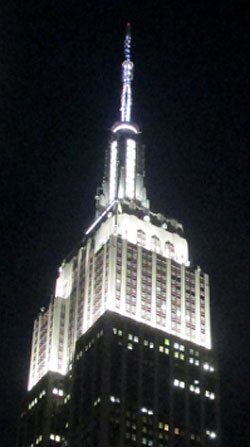
Photo by Jim Hill
… and eventually wound up just below Times
Square (right behind where the Waterford Crystal Times Square New
Year's Eve Ball is kept).

Photo by Jim Hill
But you know what we discovered en route? Right in the heart
of Manhattan's Garment District
along Broadway between 36th and 41st? This incredibly cool series of life-like
and life-sized sculptures that Seward
Johnson has created.

Photo by Jim Hill
And — yes — that is Abraham Lincoln (who seems to have
slipped out of WDW's Hall of Presidents when no one was looking and is now
leading tourists around Times Square). These 18 painted
bronze pieces (which were just installed late this past Sunday night / early
Monday morning) range from the surreal to the all-too-real.

Photo by Jim Hill
Some of these pieces look like typical New Yorkers. Like the
business woman planning out her day …

Photo by Jim Hill
… the postman delivering the mail …

Photo by Jim Hill
… the hot dog vendor working at his cart …

Photo by Jim Hill
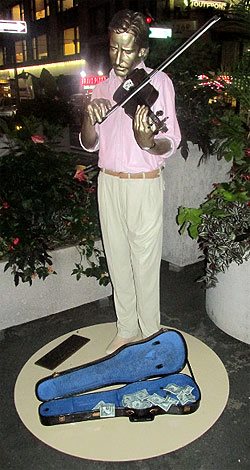
Photo by Jim Hill
… the street musician playing for tourists …

Photo by Jim Hill
Not to mention the tourists themselves.
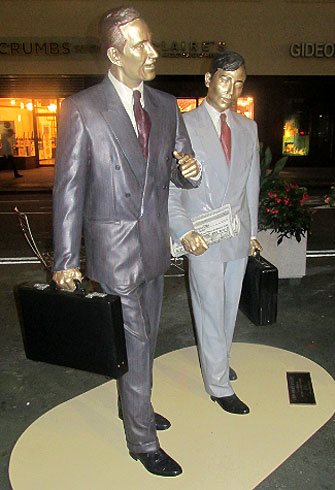
Photo by Jim Hill
But right alongside the bronze businessmen …

Photo by Jim Hill
… and the tired grandmother hauling her groceries home …
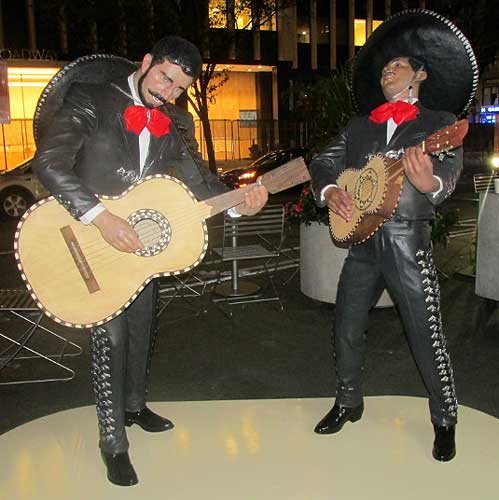
Photo by Jim Hill
… there were also statues representing people who were
from out-of-town …

Photo by Jim Hill
… or — for that matter — out-of-time.

Photo by Jim Hill
These were the Seward Johnson pieces that genuinely beguiled. Famous impressionist paintings brought to life in three dimensions.

Note the out-of-period water bottle that some tourist left
behind. Photo by Jim Hill
Some of them so lifelike that you actually had to pause for
a moment (especially as day gave way to night in the city) and say to yourself
"Is that one of the bronzes? Or just someone pretending to be one of these
bronzes?"
Mind you, for those of you who aren't big fans of the
impressionists …

Photo by Jim Hill
… there's also an array of American icons. Among them
Marilyn Monroe …
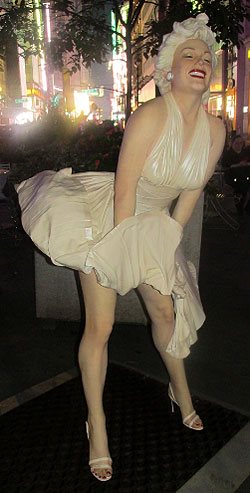
Photo by Jim Hill
… and that farmer couple from Grant Wood's "American
Gothic."

Photo by Jim Hill
But for those of you who know your NYC history, it's hard to
beat that piece which recreates Alfred Eisenstaedt's famous photograph of V-J Day in Times Square.

Photo by Jim Hill
By the way, a 25-foot-tall version of this particular Seward
Johnson piece ( which — FYI — is entitled "Embracing Peace") will actually
be placed in Times Square for a few days on or around August 14th to commemorate the 70th
anniversary of Victory Over Japan Day (V-J Day).

Photo by Jim Hill
By the way, if you'd like to check these Seward Johnson bronzes in
person (which — it should be noted — are part of the part of the Garment
District Alliance's new public art offering) — you'd best schedule a trip to
the City sometime over the next three months. For these pieces will only be on
display now through September 15th.
General
Wondering what you should “Boldly Go” see at the movies next year? The 2015 Licensing Expo offers you some clues

Greeting from the 2015 Licensing Expo, which is being held
at the Mandalay Bay
Convention Center in Las
Vegas.

Photo by Jim Hill
I have to admit that I enjoy covering the Licensing Expo.
Mostly becomes it allows bloggers & entertainment writers like myself to
get a peek over the horizon. Scope out some of the major motion pictures &
TV shows that today's vertically integrated entertainment conglomerates
(Remember when these companies used to be called movie studios?) will be
sending our way over the next two years or so.
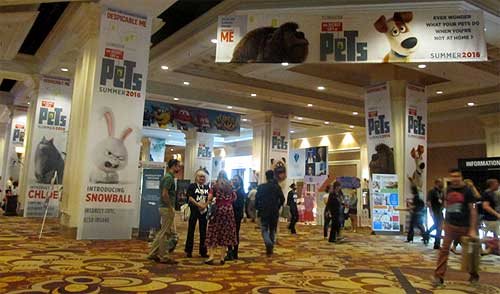
Photo by Jim Hill
Take — for example — all of "The Secret Life of
Pets" banners that greeted Expo attendees as they made their way to the
show floor today. I actually got to see some footage from this new Illumination
Entertainment production (which will hit theaters on July 8, 2016) the last time I was in Vegas. Which
was for CinemaCon back in April. And the five or so minutes of film that I viewed
suggested that "The Secret Life of Pets" will be a really funny
animated feature.

Photo by Jim Hill
Mind you, Universal Pictures wanted to make sure that Expo
attendees remembered that there was another Illumination Entertainment production
coming-to-a-theater-near-them before "The Secret Life of Pets" (And
that's "Minions," the "Despicable Me" prequel. Which
premieres at the Annecy International Animated Film Festival next week but
won't be screened stateside 'til July 10th of this year). Which is why they had
three minions who were made entirely out of LEGOS loitering out in the lobby.

Photo by Jim Hill
And Warner Bros. — because they wanted "Batman v
Superman: Dawn of Justice" to start trending on Twitter today — brought
the Batmobile to Las Vegas.
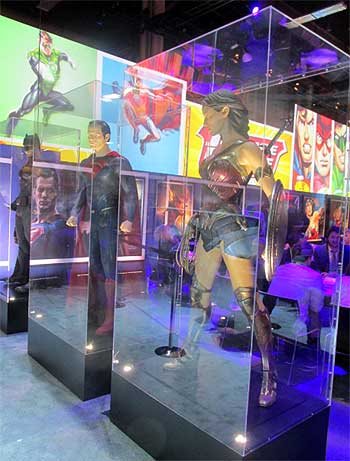
Photo by Jim Hill
Not to mention full-sized macquettes of Batman, Superman and
Wonder Woman. Just so conventioneers could then see what these DC superheroes
would actually look like in this eagerly anticipated, March 25, 2016 release.

Photo by Jim Hill
That's the thing that can sometimes be a wee bit frustrating
about the Licensing Expo. It's all about delayed gratification. You'll come
around a corner and see this 100 foot-long ad for "The Peanuts Movie"
and think "Hey, that looks great. I want to see that Blue Sky Studios production
right now." It's only then that you notice the fine print and realize that
"The Peanuts Movie" doesn't actually open in theaters 'til November
6th of this year.

Photo by Jim Hill
And fan of Blue Sky's "Ice Age" film franchise are in for an even
longer wait. Given that the latest installment in that top grossing series
doesn't arrive in theaters 'til July
15, 2016.

Photo by Jim Hill
Of course, if you're one of those people who needs immediate
gratification when it comes to your entertainment, there was stuff like that to
be found at this year's Licensing Expo. Take — for example — how the WWE
booth was actually shaped like a wrestling ring. Which — I'm guessing — meant
that if the executives of World Wrestling Entertainment, Inc. didn't like
the offer that you were making, they were then allowed to toss you out over the
top rope, Royal Rumble-style.

Photo by Jim Hill
I also have to admit that — as a longtime Star Trek fan —
it was cool to see the enormous Starship Enterprise that hung in place over the
CBS booth. Not to mention getting a glimpse of the official Star Trek 50th
Anniversary logo.
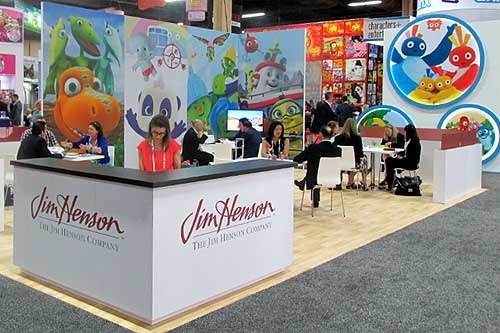
Photo by Jim Hill
I was also pleased to see lots of activity in The Jim Henson
Company booth. Which suggests that JHC has actually finally carved out a
post-Muppets identity for itself.

Photo by Jim Hill
Likewise for all of us who were getting a little concerned
about DreamWorks Animation (what with all the layoffs & write-downs &
projects that were put into turnaround or outright cancelled last year), it was
nice to see that booth bustling.

Photo by Jim Hill
Every so often, you'd come across some people who were
promoting a movie that you weren't entirely sure that you actually wanted to
see (EX: "Angry Birds," which Sony Pictures Entertainment / Columbia
Pictures will be releasing to theaters on May 20, 2016). But then you remembered that Clay Kaytis —
who's this hugely talented former Walt Disney Animation Studios animator — is
riding herd on "Angry Birds" with Fergal Reilly. And you'd think
"Well, if Clay's working on 'Angry Birds,' I'm sure this animated feature
will turn out fine."

Photo by Jim Hill
Mind you, there were reminders at this year's Licensing Expo
of great animated features that we're never going to get to see now. I still
can't believe — especially after that brilliant proof-of-concept footage
popped up online last year — that Sony execs decided not to go forward
with production of Genndy Tartakovsky's
"Popeye" movie. But that's the
cruel thing about the entertainment business, folks. It will sometime break
your heart.
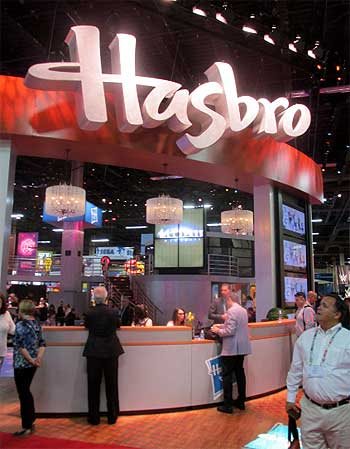
Photo by Jim Hill
And make no mistake about this. The Licensing Expo is all
about business. That point was clearly driven home at this year's show when —
as you walked through the doors of the Mandalay
Bay Convention Center
— the first thing that you saw was the Hasbros Booth. Which was this gleaming,
sleek two story-tall affair full of people who were negotiating deals &
signing contracts for all of the would-be summer blockbusters that have already
announced release dates for 2019 & beyond.

Photo by Jim Hill
"But what about The Walt Disney Company?," you
ask. "Weren't they represented on the show floor at this year's Licensing
Expo?" Not really, not. I mean, sure. There were a few companies there hyping
Disney-related products. Take — for example — the Disney Wikkeez people.
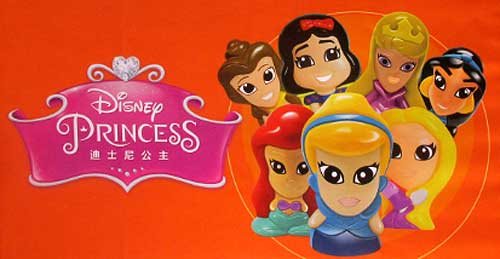
Photo by Jim Hill
I'm assuming that some Disney Consumer Products exec is
hoping that Wikkeez will eventually become the new Tsum Tsum. But to be blunt,
these little hard plastic figures don't seem to have the same huggable charm
that those stackable plush do. But I've been wrong before. So let's see what
happens with Disney Wikkeez once they start showing up on the shelves of the
Company's North American retail partners.

Photo by Jim Hill
And speaking of Disney's retail partners … They were
meeting with Mouse House executives behind closed doors one floor down from the
official show floor for this year's Licensing Expo.

Photo by Jim Hill
And the theme for this year's invitation-only Disney shindig? "Timeless
Stories" involving the Disney, Pixar, Marvel & Lucasfilm brands that
would then appeal to "tomorrow's consumer."

Photo by Jim Hill
And just to sort of hammer home the idea that Disney is no
longer the Company which cornered the market when it comes to little girls
(i.e., its Disney Princess and Disney Fairies franchises), check out this
wall-sized Star Wars-related image that DCP put up just outside of one of its
many private meeting rooms. "See?," this carefully crafted photo
screams. "It isn't just little boys who want to wield the Force. Little
girls also want to grow up and be Lords of the Sith."
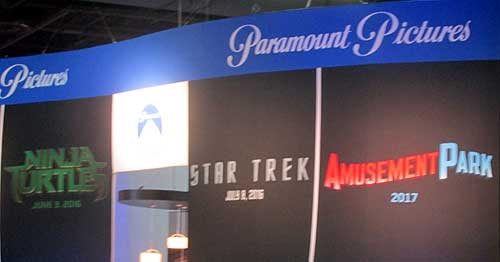
Photo by Jim Hill
One final, kind-of-ironic note: According to this banner,
Paramount Pictures will be releasing a movie called "Amusement Park"
to theaters sometime in 2017.

Photo by Jim Hill
Well, given all the "Blackfish" -related issues
that have been dogged SeaWorld Parks & Entertainment over the past two years, I'm
just hoping that they'll still be in the amusement park business come 2017.
Your thoughts?
General
It takes more than three circles to craft a Classic version of Mickey Mouse
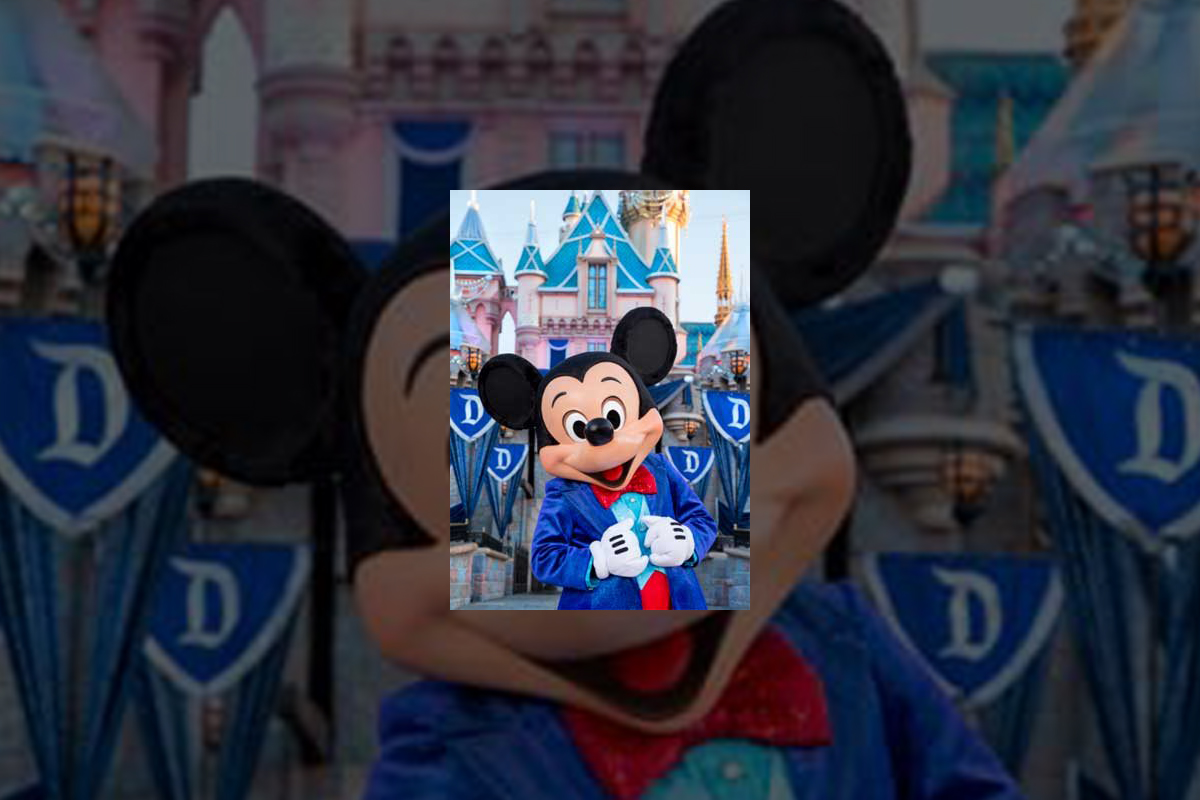
You know what Mickey Mouse looks like, right? Little guy,
big ears?
Truth be told, Disney's corporate symbol has a lot of
different looks. If Mickey's interacting with Guests at Disneyland
Park (especially this summer, when
the Happiest Place on Earth
is celebrating its 60th anniversary), he looks & dresses like this.
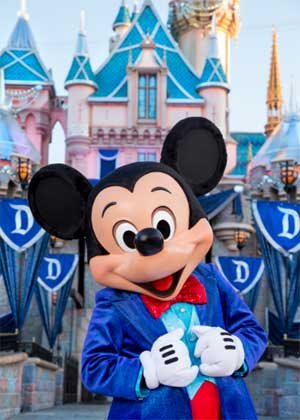
Copyright Disney Enterprises,
Inc.
All rights reserved
Or when he's appearing in one of those Emmy Award-winning shorts that Disney
Television Animation has produced (EX: "Bronco Busted," which debuts
on the Disney Channel tonight at 8 p.m. ET / PT), Mickey is drawn in a such a
way that he looks hip, cool, edgy & retro all at the same time.
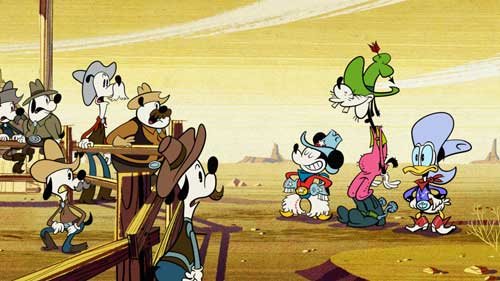
Copyright Disney Enterprises, Inc. All rights
reserved
Looking ahead to 2017 now, when Disney Junior rolls out "Mickey and the
Roadster Racers," this brand-new animated series will feature a sportier version
of Disney's corporate symbol. One that Mouse House managers hope will persuade
preschool boys to more fully embrace this now 86 year-old character.

Copyright Disney Enterprises,
Inc. All rights reserved
That's what most people don't realize about the Mouse. The
Walt Disney Company deliberately tailors Mickey's look, even his style of
movement, depending on what sort of project / production he's appearing in.
Take — for example — Disney
California Adventure
Park's "World of Color:
Celebrate!" Because Disney's main mouse would be co-hosting this new
nighttime lagoon show with ace emcee Neil Patrick Harris, Eric Goldberg really had
to step up Mickey's game. Which is why this master Disney animator created
several minutes of all-new Mouse animation which then showed that Mickey was
just as skilled a showman as Neil was.

Copyright Disney Enterprises,
Inc.
All rights reserved
Better yet, let's take a look at what the folks at Avalanche Studios just went
through as they attempted to create a Classic version of Mickey & Minnie.
One that would then allow this popular pair to become part of Disney Infinity
3.0.
"I won't lie to you. We were under a lot of pressure to
get the look of this particular version of Mickey — he's called Red Pants
Mickey around here — just right," said Jeff Bunker, the VP of Art
Development at Avalanche Studios, during a recent phone interview. "When
we brought Sorcerer Mickey into Disney Infinity 1.0 back in January of 2014,
that one was relatively easy because … Well, everyone knows what Mickey Mouse
looked like when he appeared in 'Fantasia.' "

Copyright Disney Enterprises,
Inc. All rights reserved
"But this time around, we were being asked to design
THE Mickey & Minnie," Bunker continued. "And given that these Classic
Disney characters have been around in various different forms for the better
part of the last century … Well, which look was the right look?"
Which is why Jeff and his team at Avalanche Studios began watching hours &
hours of Mickey Mouse shorts. As they tried to get a handle on which look would
work best for these characters in Disney Infinity 3.0.

Copyright Disney
Enterprises, Inc. All rights reserved
"And we went all the way back to the very start of Mickey's career. We began
with 'Steamboat Willie' and then watched all of those black & white Mickey shorts
that Walt made back in the late 1920s & early 1930s. From there, we
transitioned to his Technicolor shorts. Which is when Mickey went from being
this pie-eyed, really feisty character to more of a well-behaved leading
man," Bunker recalled. "We then finished out our Mouse marathon by
watching all of those new Mickey shorts that Paul Rudish & his team have
been creating for Disney Television Animation. Those cartoons really recapture
a lot of the spirit and wild slapstick fun that Mickey's early, black &
white shorts had."
But given that the specific assignment that Avalanche Studios had been handed
was to create the most appealing looking, likeable version of Mickey Mouse
possible … In the end, Jeff and his team wound up borrowing bits & pieces
from a lot of different versions of the world's most famous mouse. So that
Classic Mickey would then look & move in a way that best fit the sort of
gameplay which people would soon be able to experience with Disney Infinity
3.0.

Copyright Disney Enterprises,
Inc. All rights reserved
"That — in a lot of ways — was actually the toughest
part of the Classic Mickey design project. You have to remember that one of the
key creative conceits of Disney Infinity
is that all the characters which appear in this game are toys," Bunker
stated. "Okay. So they're beautifully detailed, highly stylized toy
versions of beloved Disney, Pixar, Marvel & Lucasfilm characters. But
they're still supposed to be toys. So our Classic versions of Mickey &
Minnie have the same sort of thickness & sturdiness to them that toys have.
So that they'll then be able to fit right in with all of the rest of the
characters that Avalanche Studios had previously designed for Disney Infinity."
And then there was the matter of coming up with just the
right pose for Classic Mickey & Minnie. Which — to hear Jeff tell the
story — involved input from a lot of Disney upper management.
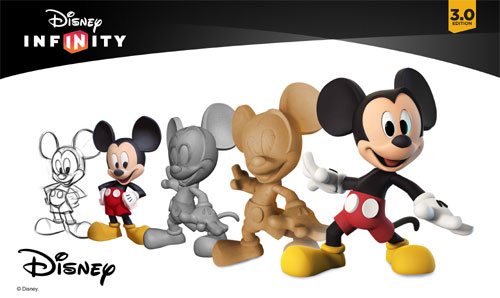
Copyright Disney Enterprises,
Inc. All rights reserved
"Everyone within the Company seemed to have an opinion
about how Mickey & Minnie should be posed. More to the point, if you Google
Mickey, you then discover that there are literally thousands of poses out there
for these two. Though — truth be told — a lot of those kind of play off the
way Mickey poses when he's being Disney's corporate symbol," Bunker said.
"But what I was most concerned about was that Mickey's pose had to work
with Minnie's pose. Because we were bringing the Classic versions of these
characters up into Disney Infinity 3.0 at the exact same time. And we wanted to
make sure — especially for those fans who like to put their Disney Infinity
figures on display — that Mickey's pose would then complement Minnie.
Which is why Jeff & the crew at Avalanche Studios
decided — when it came to Classic Mickey & Minnie's pose — that they
should go all the way back to the beginning. Which is why these two Disney icons
are sculpted in such a way that it almost seems as though you're witnessing the
very first time Mickey set eyes on Minnie.

Copyright Disney Enterprises,
Inc. All rights reserved
"And what was really great about that was — as soon as
we began showing people within the Company this pose — everyone at Disney
quickly got on board with the idea. I mean, the Classic Mickey that we sculpted
for Disney Infinity 3.0 is clearly a very playful, spunky character. But at the
same time, he's obviously got eyes for Minnie," Bunker concluded. "So
in the end, we were able to come up with Classic versions of these characters
that will work well within the creative confines of Disney Infinity 3.0 but at
the same time please those Disney fans who just collect these figures because
they like the way the Disney Infinity characters look."
So now that this particular design project is over, does
Jeff regret that Mouse House upper management was so hands-on when it came to
making sure that the Classic versions of Mickey & Minnie were specifically
tailored to fit the look & style of gameplay found in Disney Infinity 3.0?

Copyright Lucasfilm / Disney
Enterprises, Inc. All rights reserved
"To be blunt, we go through this every time we add a new character to the
game. The folks at Lucasfilm were just as hands-on when we were designing the
versions of Darth Vader and Yoda that will also soon be appearing in Disney
Infinity 3.0," Bunker laughed. "So in the end, if the character's
creators AND the fans are happy, then I'm happy."
This article was originally posted on the Huffington Post's Entertainment page on Tuesday, June 9, 2015
-

 Film & Movies7 months ago
Film & Movies7 months agoBefore He Was 626: The Surprisingly Dark Origins of Disney’s Stitch
-

 History5 months ago
History5 months agoCalifornia Misadventure
-

 History10 months ago
History10 months agoThe Super Bowl & Disney: The Untold Story Behind ‘I’m Going to Disneyland!’
-

 Television & Shows11 months ago
Television & Shows11 months agoHow the Creators of South Park Tricked A-List Celebrities to Roast Universal – “Your Studio & You”
-

 Film & Movies6 months ago
Film & Movies6 months agoThe Best Disney Animation Film Never Made – “Chanticleer”
-

 Theme Parks & Themed Entertainment5 months ago
Theme Parks & Themed Entertainment5 months agoThe ExtraTERRORestrial Files
-

 History6 months ago
History6 months agoWhy Disney’s Animal Kingdom’s Beastly Kingdom Was Never Built
-

 Television & Shows7 months ago
Television & Shows7 months agoThe Untold Story of Super Soap Weekend at Disney-MGM Studios: How Daytime TV Took Over the Parks






